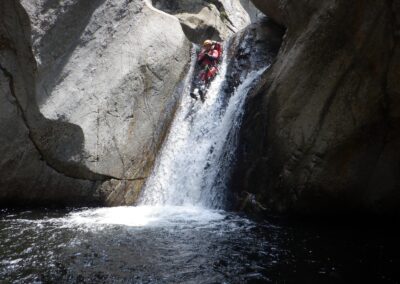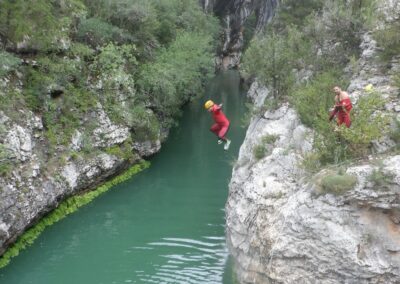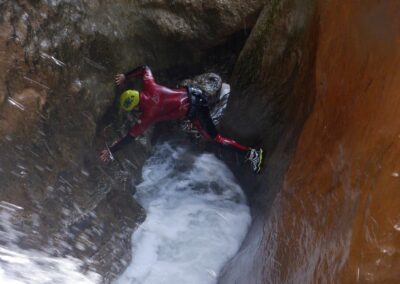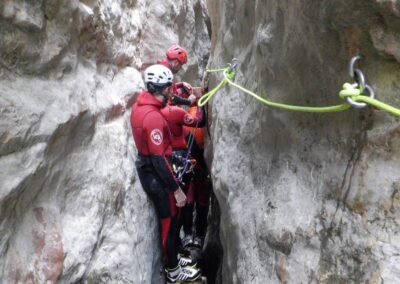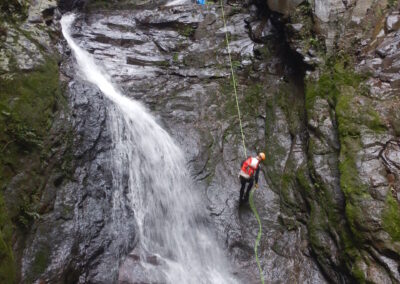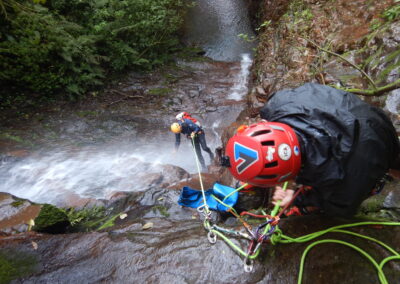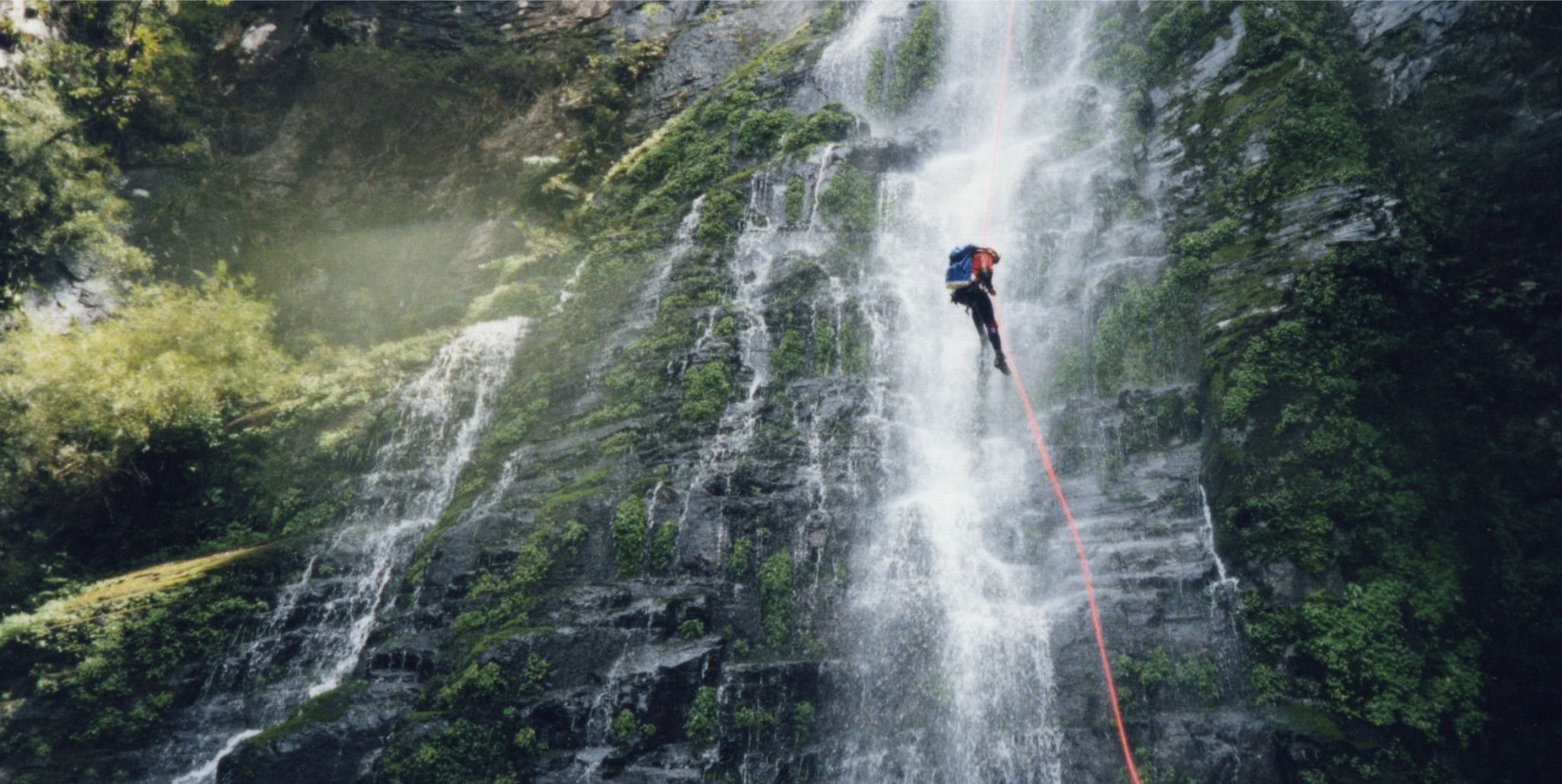What is Canyoning?
Canyoning is an activity that consists of descending canyons, following a watercourse (even if the watercourse is intermittent, causing the canyon to be dry sometimes), using appropriate techniques and equipment. During the descent, the practitioner will face several vertical and aquatic obstacles, using techniques specific to canyoning, as well as techniques imported or adapted from speleology, mountaineering and whitewater sports. It is worth noting that canyoning should not be confused with cascading, which consists of descending waterfalls using fixed ropes.
The techniques used in canyoning include: rappelling, ascending and other rope progression techniques, walking on varied terrains, water trekking, swimming and floating, climbing and downclimbing, and jumping and sliding down toboggans. It is also important to know how to identify possible water hazards and how to overcome them. The autonomous canyoneer should have sound knowledge of physics, physiology and nutrition; and must master self-rescue and first-aid techniques, both of which are essential to deal with any incidents that may arise.
As to canyoning equipment, it includes a helmet, a harness with tethers, a descender (usually a figure 8), carabiners, a backpack suitable for canyoning, a waterproof compartment (usually a keg or barrel), rope climbing equipment, and clothing and footwear suitable for canyoning, among others. The geographic location of the canyon and the seasons can influence the clothing required, which is usually a neoprene suit, but can also be trekking or mountaineering clothing in dry canyons or dry suits in colder canyons. As for anchors, they depend fundamentally on the characteristics of the canyon, especially the type of rock, and can be natural, mechanical or chemical.
In each canyon descended, the techniques applied will vary according to its characteristics. For instance, there are aquatic canyons, which require the use of techniques such as jumps, slides and whitewater techniques; as well as more vertical canyons, which require mastery of waterfall rappelling techniques.
In Aparados da Serra Geral, the canyons are marked by their verticality, with barely any aquatic canyons. This means that techniques such as jumps and slides are not used often, but that does not exclude the need for knowledge of whitewater techniques, which will be required in pools and when crossing rivers. In general, canyoning in Aparados da Serra Geral will require the use of neoprene suits, whose thickness will depend on the season and on the amount of water inside the canyon.
History
The origin of canyoning can be traced back to the forays into canyons using speleology techniques that took place in the end of the 19th century and in the beginning of the 20th century, especially in France and Spain. At that time, it was about exploring and discovering a new environment, without any thought of creating an independent activity. Furthermore, the materials used were still quite rudimentary, such as heavy speleology ladders, wooden boats, etc.
From this embryonic period of activity, the following events can be highlighted: in 1888, Édouard Martel made the descent of the Abyss of Bramabiau, which could be compared to a canyon descent; in 1893, Armand Janet made the first descent of the l’Artuby canyon, in Verdon; between 1903 and 1906, F. Fournier made the first observations of the Kakouetta, Holzarté and Olhadubie canyons, in the French Basque Country; from 1904 on, Lucien Briet explored the canyons of Haute-Aragon and the Sierra de Guara: Val de Onsera, Val d’ Ordesa, Rio Vero, Péonéra, Escuain, Miraval, Mascun, Guatizalema Gorges and Glocé Gorges.
During the first half of the 20th century, explorations continued, mainly carried out by speleologists.
In the second half of the 20th century, the first outlines of canyoning as an autonomous activity began to emerge.
Between 1951 and 1968 Paul Minvielle and his son Pierre explored a number of canyons in the Spanish Pyrenees: Canal del Palomo, Los Oscuros, the Estréchos del Balces, the Rio Vero, Le Choca and the Mascun.
In the 1970s, the first canyoning activities began to be organized by speleology instructors and mountain guides in the Sierra de Guara in Spain and in the French Southern Alps. This was the beginning of a new activity, which then spread throughout France, then Europe and later the entire world.
The late 1980s and the 1990s were fundamental for the setting up of the federative structure of the activity. In 1986, the French Speleology Federation was put in charge of organizing canyoning in France. In 1988, it created the Canyon Commission, welcoming the French Mountain, Climbing and Canoe-Kayaking Federations. In 1989, the Canyon Commission organized the first courses for canyoning monitors (“moniteur en canyonisme”). In 1990, the Commission held the first improvement course and, in 1991, they held the first training course for instructors of the French Speleology Federation. Finally, in 1996, the French Canyoning School (“École Française de Descente de Canyon”) was created and became responsible for forming the staff for the school and canyoning practitioners. During this period, canyoning evolved into an autonomous activity, independent from speleology and mountaineering, with its own techniques and equipment.
In Brazil, canyoning began to be practiced between the late 1980s and the early 1990s.
In 1988, the 1st Latin American and Caribbean Speleology Congress was held in Belo Horizonte (MG), where “open-air speleology” was presented. In 1989, what was perhaps the first article about canyoning in Brazil was published in Revista Geográfica Universal (the Brazilian edition of National Geographic). During this period, the work of pioneering teams such as H2Omem from São Paulo and Canion Inc. from Rio Grande do Sul stood out.
In the Aparados da Serra Geral region, the practice of canyoning began in 1997, on the initiative of members of Canion Inc., who started equipping the Malacara Canyon.
On July 14th, 1998, the Serra Geral Canyons Association (ACASERGE) was created. It was the first Brazilian legal entity dedicated to the practice of canyoning. At that time, priority was given to the technical training of the Association’s members and to the equipping of the canyons located within the Serra Geral National Park, in order to ensure that canyoning was included in the Management Plan for the Aparados da Serra and Serra Geral National Parks, which was about to be drawn up. Within this effort, many other canyons were equipped: Cânion dos Índios, Molha-Côco, Corujão, Fortaleza, Cânion das Pedras, Ravina dos Amigos, and Ravina do Espigão. In some of these canyons, such as Malacara and Cânion dos Índios, several canyoning routes have been set up.
In November 1998, a Brazilian-French expedition was carried out in the canyons of Aparados da Serra Geral. The expedition was composed of members of ACASERGE and of the French Federation of Speleology.
In November 1999, the École Française de Descente de Cânion held a Preparatory Course for Monitors in Praia Grande, which was followed by a Monitors Exam in March 2000. The monitors approved in that exam were the first ones formed by the École Française de Descent de Canyon in Brazil.
In October 2000, the 1st Brazilian Canyoning Meeting was held in Chapada dos Veadeiros (GO). It was in that meeting that the Brazilian Canyoning Association (ABCânion) was founded.
More details about the origin of canyoning in Aparados da Serra Geral can be found in the e-book “Memories of Canyoning in Aparados da Serra: Origins” and in the documentary “Memories of Canyon Crossings in Aparados da Serra”.

